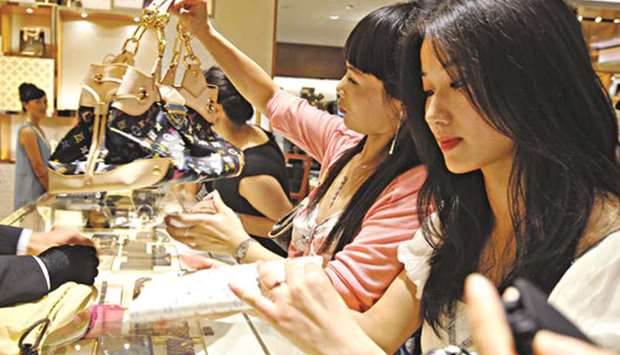But the sector looks very different from back in 2012, when conspicuous spending by officials greasing the wheels of contracts was a key driver – spurring the crackdown on graft. Today, newly affluent consumers unaffected by government curbs are setting the pace. China’s rising middle class is so important that it’s set to be a main engine for luxury growth globally, Bain & Co said in a recent report on the outlook to 2020.
“The anti-corruption campaign has removed the froth from the market, as spending and consumption is now very largely legitimate,” Luca Solca, head of luxury goods research at Exane BNP Paribas, said in a September 25 e-mail.
The composition of China’s high-end spending has also changed over the past half-a-decade. Gift-giving used to be dominated by purchases for males, with luxury watches a particular favourite. The anti-graft push caused such sales to plunge. Now, the emphasis has switched to spending by women on designer handbags and costly perfume.
Swiss watch exports to Hong Kong, a favourite destination for Chinese buyers, fell 25% last year, and the value of the market has halved in four years, according to the Federation of the Swiss Watch Industry.
China’s luxury market “was mainly dominated by the male segment,” Serena Rovai, a professor at France’s La Rochelle Business School, wrote in her book “Luxury the Chinese Way.” Now, there’s a more prominent female presence, “thanks to the increasing purchasing power of women and the anti-corruption policy regarding often male-driven gift-giving,” she wrote.
Companies that have seen strong results in China this year include: Burberry Group Plc reported “mid-teens percentage growth” in retail sales in the April-to-June quarter, with sales boosted by exposure on the WeChat social-media platform. Kering, the owner of Gucci Group, said mainland revenue from its luxury brands jumped almost 50% in the first half compared with the first six months of last year. Sales at its Yves Saint Laurent unit were up nearly 67%.LVMH Moet Hennessy Louis Vuitton SE reported continuing robust upward momentum for wines and spirits, thanks in part to sales of Hennessy Cognac for Chinese New Year celebrations.
Results are proving so strong that Erwan Rambourg, global co-head of consumer and retail research at HSBC Holdings Plc, says his bank’s already bullish forecast of 10% growth for China’s luxury market this year – versus 7% globally – could be surpassed.
The upturn, which started in the fourth quarter of 2016, has been helped by a turnaround in China’s exchange rate, along with gains in real-estate and equities – all of which have boosted the spending power of the nation’s consumers.
“You’ve had a bit of excess purchasing reversing very low purchasing, and we don’t think that can go on forever,” Rambourg said in an interview by phone this week from New York. “Pent-up demand, by definition, doesn’t sustain.”
Yet an expanding mass market is lifting some high-end goods, like the premium Chinese liquor segment that was hit hard after 2012.
Aidan Yao, a senior emerging markets economist at AXA Investment Managers, said this week that the liquor increase is consistent with broader strength seen in domestic demand, retail sales and consumer spending.
China’s luxury-goods market is growing steadily again, nearly five years after it was knocked off course by President Xi Jinping’s anti-corruption drive. But the sector looks very different from back in 2012, when conspicuous spending by officials greasing the wheels of contracts was a key driver – spurring the crackdown on graft. Today, newly affluent consumers unaffected by government curbs are setting the pace.

